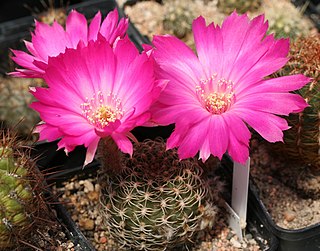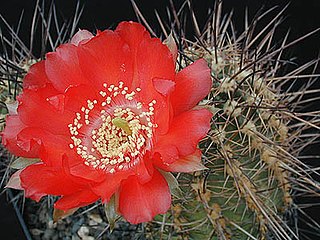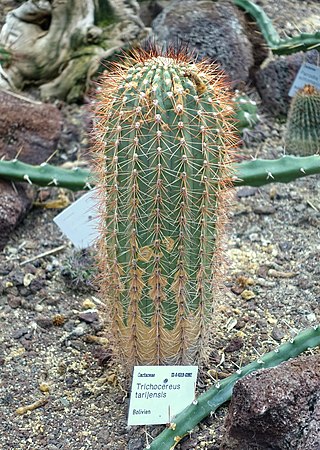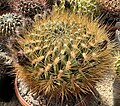
Nathaniel Lord Britton was an American botanist and taxonomist who co-founded the New York Botanical Garden in the Bronx, New York.

Echinopsis is a genus of cacti native to South America, sometimes known as hedgehog cactus, sea-urchin cactus or Easter lily cactus. As of October 2023, there are about 20 accepted species, ranging from large and treelike types to small globose cacti. The name derives from echinos hedgehog or sea urchin, and opsis appearance, a reference to these plants' dense coverings of spines.

Pachycereus is a genus of large cacti native to Central America and Mexico. They form large shrubs or small trees up to 15 m tall, with stout stems up to 1 m in diameter. Pachycereus comes from the ancient Greek παχύς (pachys) meaning "thick" and the Latin cereus meaning "torch".

Selenicereus, sometimes known as moonlight cactus, is a genus of epiphytic, lithophytic, and terrestrial cacti, found in Mexico, Central America, the Caribbean and northern South America. The term night-blooming cereus is also sometimes used, but this is also used for many night-blooming cacti, including Epiphyllum and Peniocereus. In 2017, the genus Hylocereus was brought into synonymy with Selenicereus. A number of species of Selenicereus produce fruit that is eaten. The fruit, known as pitaya or pitahaya in Spanish or as dragon fruit, may be collected from the wild or the plants may be cultivated.

Reicheocactus is a monotypic genus of cactus in the family Cactaceae, native to north western Argentina. It has only one known species, Reicheocactus famatimensis.

Quiabentia is a genus of cacti, closely related to Pereskiopsis.

Chamaecereus silvestrii is a species of cactus from northwestern Argentina and Bolivia. Synonyms include Echinopsis chamaecereus and Lobivia silvestrii. It has been called the peanut cactus. This plant should not be confused with Echinopsis silvestrii, a synonym of Echinopsis albispinosa, a species with a very different appearance.

Portlandia is a genus of flowering plants in the coffee family, Rubiaceae. Members of the genus are endemic to Jamaica.

Lobivia backebergii is a species of flowering plant in the cactus family Cactaceae, native to eastern Bolivia and southern Peru.

Lobivia cinnabarina is a species of cactus first described in 1885.

Acanthocalycium thionanthum is a species of Acanthocalycium from Argentina.

Echinopsis aurea, is a species of Echinopsis cactus found in Argentina.

Echinopsis haematantha, is a species of Echinopsis found in Argentina and Bolivia.

Lobivia ferox, is a species of Lobivia found in Bolivia and Argentina.

Soehrensia huascha, is a species of Soehrensia in the Cactaceae family, found in north western Argentina. First published in Cactaceae Syst. Init. 29: 5 in 2013.

Lobivia pentlandii, is a species of Lobivia found in Bolivia and Peru.

Soehrensia tarijensis, is a species of Soehrensia, in the cactus family. It is native to Bolivia and northwestern Argentina.

Lobivia pampana is a species of Lobivia found in Peru.

Lobivia arachnacantha is a species of cactus in the genus Lobivia, native to Bolivia.
Lobivia pugionacantha, is a species of Lobivia found in Argentina and Bolivia. Lobivia is a genus of cacti.







































